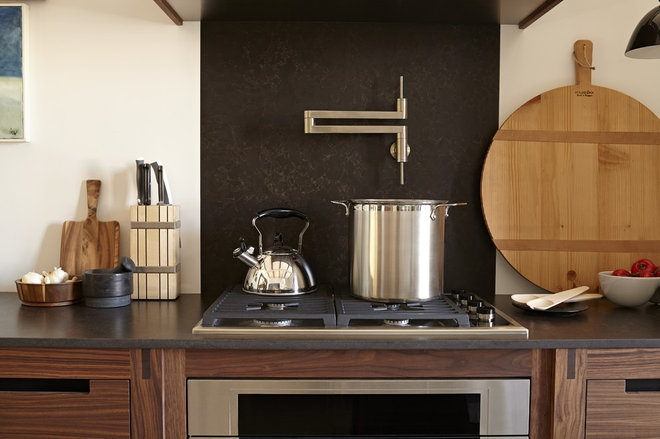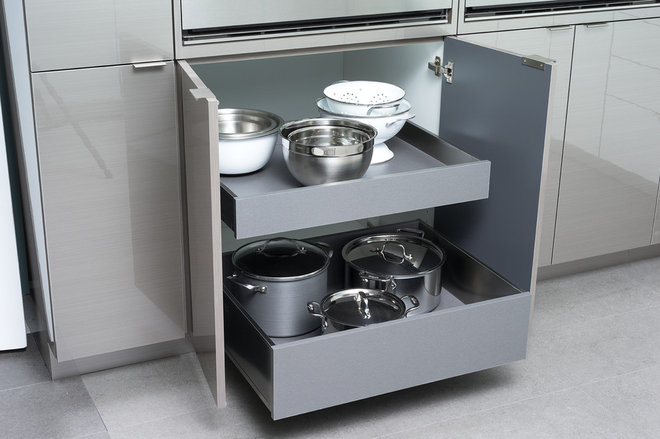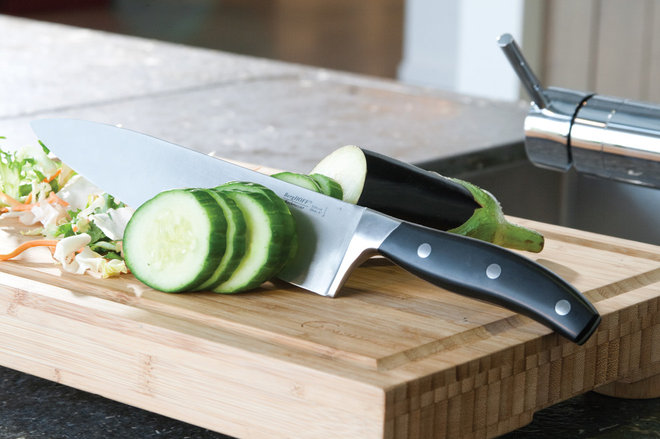Jump-Start Your Kitchen With These Minimalist Essentials
These 22 kitchen tools will get you started on your path to culinary success or delicious downsizing
Whether you’re setting up your kitchen for the first time, downsizing or just aiming to simplify your life with a more minimalist kitchen setup, this guide is a good place to begin. If you own only the 22 items on this list (we’ll assume you’re starting with a can opener) you’ll be in good shape to tackle everything from pancakes to roast chicken. What you won’t find here: cake pans, a turkey-size roasting pan, a food processor or any highly specialized tools and appliances. If and when your cooking life requires any of these items, you’ll know.
1. Stock pot. A great big pot is a must for boiling pasta, making stock and soups and handling big-batch dishes like chili. Look for a heavy stainless steel pot with a tight-fitting lid and stay-cool handles, in a 12-quart size or larger. This is a worthy splurge: A high-quality pot makes it harder to burn the bottom of that batch of tomato sauce!
2. Saucepan. A stainless steel saucepan is a kitchen workhorse, perfect for cooking smaller amounts of pasta as well as rice, beans and, yes, sauces. Look for a heavy, 4-quart stainless steel version with a lid and a stay-cool handle. A high-quality saucepan cooks more evenly and can last for decades if well cared for.
3. Wooden spoon. A wooden spoon (or two or three) is an indispensable kitchen tool. It’s useful for stirring, scraping, tasting and blending, and you don’t have to worry about the wood scratching any of your cookware. Note: Your sauce won’t be able to tell if you bought the spoon at a bargain outlet or high-end kitchen shop.
4. Skillet. If you’re going to buy just one skillet, I vote for making it a
10-inch cast-iron version. It’s budget-friendly, ovenproof, essentially nonstick once it’s well seasoned, and it can literally last for generations. (I purchased mine at an antiques mall.) Use it for searing steaks, frying and even baking.
Have room for a second pan? Go with stainless steel, or just branch out and get a bigger (or smaller) version of the same. A cast-iron skillet needn’t be expensive; just be sure to look for one that’s solid cast iron, and season it properly before use.
How to season a cast-iron pan: Rub about a tablespoon of olive or vegetable oil over the surface of the clean, dry pan, inside and out. Wipe away excess oil so just a thin layer remains. Put the pan in a 300-degree oven for an hour, let cool, then rub with a clean rag. After the initial seasoning, clean your pan promptly after each use with a paper towel and a bit of oil. You can remove stuck-on food with hot water and a soft brush — but don’t use soap. Soap will remove the seasoning, which is what creates that wonderful nonstick surface.
5. Dutch oven. If you have the three pots and pans described so far, you could certainly make do without a Dutch oven. But do you want to make do without it? This heavy-duty, typically enameled cast-iron pot is beloved by cooks for good reason: It retains heat extremely well; goes from stovetop to oven to table with ease; and can handle everything from braises, soups and stews to a whole roast chicken or a loaf of bread.
A 5½-quart pot is ample for most purposes, although you can certainly go bigger. But be warned: These pots are extremely heavy. I once dropped my just-washed Dutch oven on our glass-top stove, and it cracked the stovetop (with not a mark on the Dutch oven). Unless you inherit one, a Dutch oven is a pretty hefty investment — but its versatility and long life make it worth it.
6. Mixing bowls. Stainless steel mixing bowls are lightweight, virtually indestructible and endlessly useful for mixing and prepping ingredients. Pick a set of
nesting bowls to maximize space. Just be sure they’re actually made from stainless steel and not aluminum, which is reactive and may affect your ingredients.
7. Colander. A sturdy colander in a generous size can handle everything from straining a big pot of pasta to washing berries. It can even stand in as a fruit bowl on the counter.
8. Cutting board. Hefty wood or simple plastic? Each has its die-hard fans. Wood is easier on knives but ostensibly more difficult to sanitize; plastic can wear down your knives faster and may harbor bacteria deep inside the cut marks.
The important thing, food safety-wise, is to reserve one cutting board solely for handling raw meats and to sanitize it after each use.
9. Baking sheet. A baking sheet with a rim around all four sides (as opposed to a cookie sheet with only one or two rimmed sides) can be used for cookies, of course, but also for roasting veggies, chicken and all sorts of other dishes.
Aluminum is a popular choice because it heats and cools quickly, which can keep delicate items from burning. Go with natural aluminum — a more versatile choice than nonstick, because it can handle higher temperatures — in a half-sheet-pan size, which fits well in most ovens. There’s no need to break the bank on a sheet pan, but avoid pans that feel really flimsy.
10. Baking dish. A 9-by-13-inch glass or ceramic baking dish is something I’d never want my kitchen to be without. Use it for baking all sorts of side dishes and casseroles, baked pastas and even cake. If you want to add a second baking dish, get a larger size for bigger gatherings and potlucks.
11. Measuring cups and spoons. Dry and liquid measuring cups technically contain the same volumes, but the difference in their designs makes it easier to get accurate measurements with each, so it’s important to have both.
A set of measuring spoons, a set of dry measuring cups and a glass 2-cup liquid measure should be able to handle all your needs. Metal cups and spoons will last longer than plastic, but either will get the job done.
12. Whisk. Use a whisk for beating eggs, whipping cream and mixing batters. You can even use it as an alternative to a sifter by fluffing up flour and other dry ingredients before adding them to your mixture. Choose a medium-size metal sauce whisk (also called a French whisk) for maximum versatility.
13. Chef’s knife. A good chef’s knife can help you make quick work of a pile of vegetables. The 8-inch size is big enough to handle most kitchen jobs without being unwieldy. A quality chef’s knife is something you’ll keep in your arsenal for many years, so choose a high-quality one that feels good in your hand.
14. Serrated knife. A bread knife is (of course) good for slicing that fresh baguette, but it’s also aces at slicing tomatoes and other tricky produce. A bread knife typically doesn’t carry as much of a workload as the chef’s knife, so if you want to go with a less expensive version, it won’t hurt. Then again, if you have the budget, you won’t regret putting a little more toward a really nice, hefty bread knife.
15. Paring knife. When you want to slice a lemon or just a bit of cheese, you don’t reach for the chef’s knife — you reach for this little guy. A 4-inch paring knife is so handy, you may actually want to have two around.
16. Honing steel. Those good knives deserve to be treated well, and a honing steel is your first line of defense against dull knives. Get in the habit of giving your knives a few swipes on this metal rod before each use and they’ll stay sharp longer.
17. Kitchen scissors. Useful for snipping herbs, opening packages and trimming cut flowers, you’ll want a dedicated pair of kitchen scissors in your drawer. You could use a regular pair of scissors, but kitchen shears are handy because they’re heavy-duty enough to handle cutting through chicken and tough flower stems.
18. Vegetable peeler. A good, sharp vegetable peeler will make life easier when you’re facing down a mountain of carrots and potatoes. Beyond veggies, use this handy little tool to make chocolate shavings, create long strips of veggies for salads and to zest citrus.
19. Grater. I love my microplane, but if I was going to buy only one grater, I’d make it a multisided model. With several choices of hole size, a box grater works equally well for grating a big block of cheddar or finely shredding parmesan.
Browse box graters
20. Ladle. Nothing else does the job as well when it comes to dishing up soups and stews or dolloping pancake batter into the pan. Stainless steel or plastic — either will do the trick.
21. Spatula. If you buy only one spatula, make it a fish spatula. This oblong flipper has a thin front that’s great for getting under pancakes, cookies and burgers, not to mention fish. Stainless steel works with cast iron and stainless steel pans, but get a silicone-coated version if you plan to use it with nonstick cookware.
22. Tongs. Use tongs to turn meat, pick up hot rolls, pull corn on the cob from a pot of hot water, pluck out a single strand of pasta to test doneness, even to toss and serve salads. Choose a simple 12-inch stainless steel version with a locking mechanism at the hinge end.




















